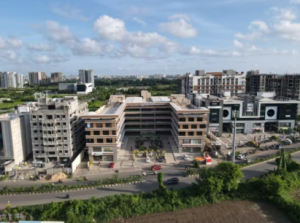Jean Francois Desormeaux Discusses The 6 Types of Industrial Property
Industrial properties are a subset of commercial properties that house industrial or manufacturing facilities, says developer Jean Francois Desormeaux.
LAVAL, QUéBEC, CANADA, April 25, 2022 /EINPresswire.com/ -- Industrial properties are a subset of commercial properties that house industrial or manufacturing facilities, says developer Jean Francois Desormeaux.Industrial properties are an important asset class for many investors. In some cities, they make up between 30% and 50% of all real estate holdings.
Industrial properties can be broken down into six categories: warehouses, distribution centers, light manufacturing facilities, heavy manufacturing facilities, fabrication plants, and processing centers. If you are considering investing in industrial property, it is important to know the benefits and risks associated with each type.
Warehouses
Warehouses are the most common type of industrial property and can be used for a number of purposes. Warehouses are most typically used for storing goods, but they can also be used for other purposes, like community or retail. Warehouses have a lower risk profile than other types of industrial properties, as they are less likely to experience vacancy rates and fluctuations in rental rates.
Warehouses can be used as either long-term or short-term investments, Jean Francois Desormeaux says. For those who are considering investing in warehouses, it is important to understand the different types of warehouse leases that may exist and if your investment strategy aligns with any specific lease type.
Distribution Centers
Distribution centers are another common type of industrial property. These properties typically have a number of loading docks and drive-in doors. Companies that need to quickly receive goods from their vendors or other locations often use distribution centers. You can typically lease these properties without any minimum lease terms, making them highly flexible for your business needs.
Try Light Manufacturing Facilities Says Jean Francois Desormeaux
Light manufacturing facilities are great for companies that need a lot of warehouse space. They can be found in residential or business areas and they often have high ceilings and loading docks. They are popular because they are affordable with low risk. The downside to this type of property is that it might not provide the best ROI.
Heavy Manufacturing Facilities
Heavy manufacturing facilities are buildings that contain heavy equipment that manufactures products. These facilities require a lot of space and are often located near railroad lines or highways. Investing in these properties usually means investing in the product they’re producing as well, Jean Francois Desormeaux explains.
Fabrication Plants
Fabrication plants are typically used to produce parts and items that are then assembled in another facility. Fabrication plants can be large or small, with some running as little as 10,000 square feet and others running up to 2 million square feet. The type of items produced can vary from car parts to furniture, depending on the needs of the plant.
One major risk associated with fabrication plants is the lack of commercial zoning for this type of property. This means that there may not be room for a retail tenant to occupy your building. There are also limitations on who can lease space in these types of buildings. For example, a typical retail tenant would require about 7600 square feet or more, but many fabrication plants have a much lower square footage requirement. Make sure you know what is required by potential tenants before investing in a fabrication plant.
Processing Centers
Processing centers are typically found in urban areas, near transportation and shipping hubs. They are used for the production of goods to be sold domestically or internationally. Processing facilities employ many different processes, from the manufacturing of plastic parts to metal stamping and painting.
Processing centers require a large amount of space and can be anywhere from 100,000 square feet up to 4 million square feet in size. They are often constructed near major highways and railroads because they require a lot of heavy equipment that needs to be delivered quickly. Processing centers only require one or two employees per 10,000 square feet; however, processing centers cannot be run without skilled managers.
Processing plants were once a popular investment option because they were usually located in densely populated areas where there was a high demand for labor; however, with so many industrial complexes opening up around the country, this has become less common. A processing plant is not necessarily an easy investment as it requires highly skilled labor. You also need access to large amounts of capital, says Jean Francois Desormeaux.
Caroline Hunter
Web Presence, LLC
email us here
Visit us on social media:
Facebook
Twitter
LinkedIn
Other
Legal Disclaimer:
EIN Presswire provides this news content "as is" without warranty of any kind. We do not accept any responsibility or liability for the accuracy, content, images, videos, licenses, completeness, legality, or reliability of the information contained in this article. If you have any complaints or copyright issues related to this article, kindly contact the author above.




